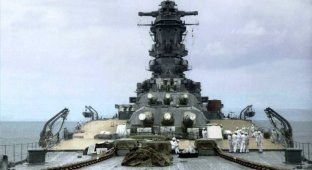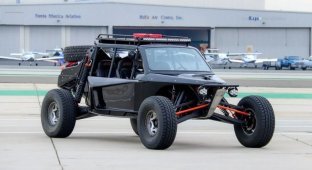Death in the shadow of a fellow. How did Musashi, one of the largest battleships in the world, perish? (9 photos)
Washington, early February 1922. The leading naval powers signed the Washington Naval Treaty, which limited the buildup of naval forces. According to the agreement, the tonnage of battleships, battlecruisers, and aircraft carriers of Japan and the United States were to be proportionately three to five in favor of the Americans. These restrictions forced Japan to revise its military doctrine. 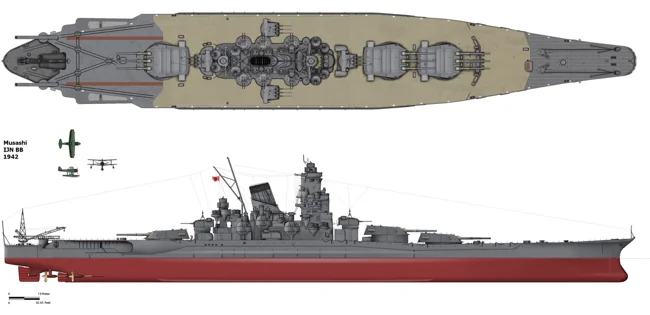
Battleship IJN Musashi as of 1942
Preparations for a future war with the United States began long before the open conflict. The Japanese strategy was to weaken the enemy with submarine and destroyer strikes, and then force a decisive naval battle in which battleships would play a decisive role.
In 1934, Japan officially withdrew from the Washington Treaty. That same year, work began on the A140-F5 battleship project, the future Yamato and Musashi, which became symbols of Japanese naval ambitions.
Under the Veil of Secrecy
The construction of "battleship No. 1" and "battleship No. 2", as they were designated at the design and assembly stage, was carried out in an atmosphere of strict secrecy. This imposed many restrictions and complicated the process. One fact is indicative: the workers put out the fires themselves, since the city firefighters were not granted access to the shipyard. The situation was particularly difficult in Nagasaki, the city where the Musashi was built and which remained a popular tourist destination.
On the first day of November 1940, Japanese police completely cordoned off the coastal area of Nagasaki. The 35,000-ton hull of the Musashi was stripped of its camouflage nets and sisal fencing, and the ship was prepared for launch. Work at the shipyard was not completed until August 1942, two months behind schedule. In August of that year, the battleship was officially commissioned into the Imperial Navy. By that time, the Yamato had already been listed as a combat unit for more than six months.
Armor is Our Everything
The battleship Musashi had one of the most powerful armor systems in the history of world shipbuilding. Over 33% of its displacement was armor, more than its predecessors, such as the Nagato, which had 31.2%. This concentration of armor was intended to make the ship virtually invulnerable to most types of weapons of its time.
The armor was not simply superimposed on the structure, but was built into the hull's power structure. This solution allowed the ship to do away with some of the bulkheads, reducing weight without compromising strength. The main armor belt was 410 mm thick and was made of Vickers Hardened steel. This level of protection allowed it to withstand a hit from a 457 mm armor-piercing shell fired from a distance of over 20 km. Each side armor plate, measuring 5.9 x 3.6 m, weighed about 68 tons and was designed in such a way that when a shell hits, it would be pressed in at an angle of 10 degrees at the bottom. 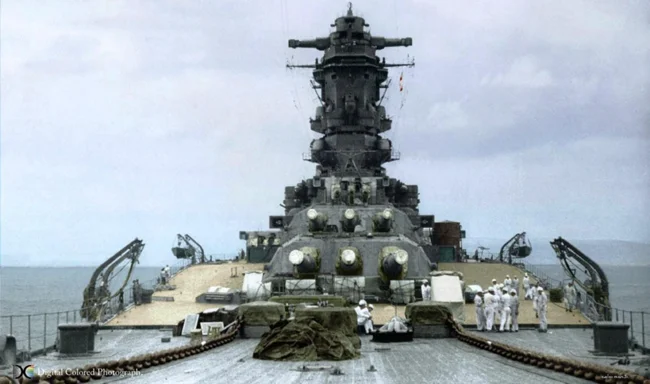
View of the bow turrets of the IJN Musashi main battery with 460 mm guns
The main battery turrets had fantastic frontal armor 650 mm thick and a 270 mm roof. The barbettes were protected by 410-560 mm armor, and the cementation depth was increased to 140 mm, which made it possible to reduce the cost of production without losing strength.
The underwater armor in the area of the magazines and engine rooms was 200-270 mm thick, gradually narrowing to 75 mm at the bottom. The main armor deck was 200-230 mm thick, which was considered sufficient to protect against a 1,000 kg armor-piercing aerial bomb dropped from a height of 3,500 m. Above it was an additional deck 30-50 mm thick, and below it was a layer of 10 mm steel, which reduced damage to the internal compartments during close explosions. 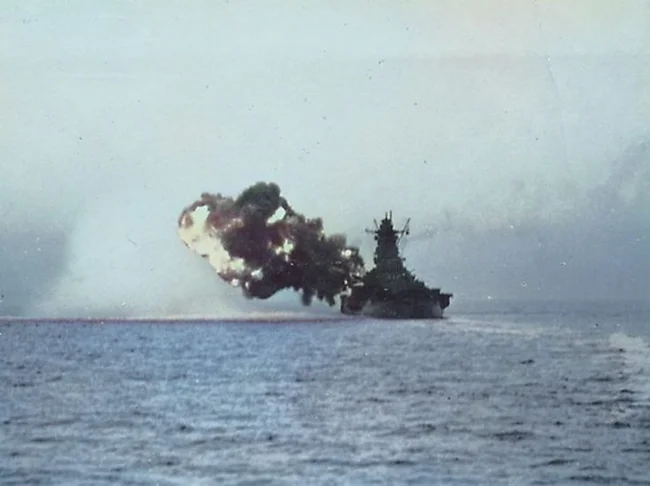
IJN Musashi during gunnery tests near Oita Prefecture, July 26, 1942
The thickness of the main deck armor in the area of the chimneys (14x15 m area) was increased to 380 mm and for the passage of gases had not grates, as usual, but perforations with a diameter of 180 mm with a total area of holes of 45% of the plate area. In addition, an inclined armor plate with a thickness of 50 mm was installed, designed to initiate the detonation of a bomb before it penetrated inside.
First damage
After commissioning, in January 1943, Musashi was sent to Truk Base in the Caroline Islands, where it joined the heavy formation of the Imperial Navy. In January 1943, the battleship was transferred to Palau. On March 29, while leaving the base, Musashi was torpedoed by the American submarine Tunny. The torpedo hit the bow outside the torpedo protection, causing a hole about 6 m in diameter. The forward compartments were flooded, including the hydroacoustic conning tower, where 7 sailors died. The total volume of water that entered was about 3,000 tons. 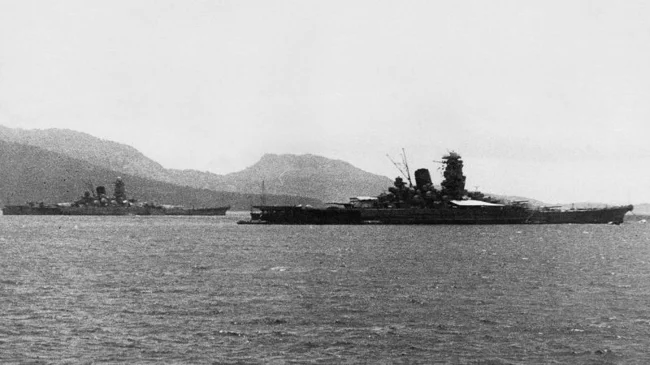
Japanese battleships IJN Musashi and IJN Yamato at the Japanese naval and air base in Truk, Caroline Islands
During the ship's restoration, the main focus was on enhancing the anti-aircraft armament, which was a response to the growing threat from US carrier-based aviation. The number of 25-mm machine guns was increased to 130, but their effectiveness remained limited due to the outdated control system and low rate of fire.
After completing repairs in June 1944, Musashi rejoined the active fleet and took part in the Battle of the Philippine Sea. Despite the scale of the battle, the battleship was not attacked by the enemy and was not damaged in any way.
General battle
The Battle of Leyte, which began on October 23, 1944, was the largest naval battle of World War II. It was part of a large-scale US operation to liberate the Philippines from Japanese occupation and included four key episodes: the battle in the Sibuyan Sea, the battles in the Surigao Strait, at Cape Engaño and at Samar Island.
In response to the American landing, the Japanese command developed the "Sho-Go 1" plan - a counteroffensive aimed at disrupting the landing. The operation provided for the coordinated actions of three strike groups. The Central Force, under the command of Vice Admiral Takeo Kurita, was of decisive importance: it included the battleships Musashi and Yamato, three more battleships, ten heavy and two light cruisers, and fifteen destroyers. From the south, the attack was carried out by Vice Admiral Shoji Nishimura's group, and from the north, the offensive was covered by Vice Admiral Jisaburō Ozawa's group. The latter had the task of distracting the attention of the main forces of the American fleet, simulating the main threat. 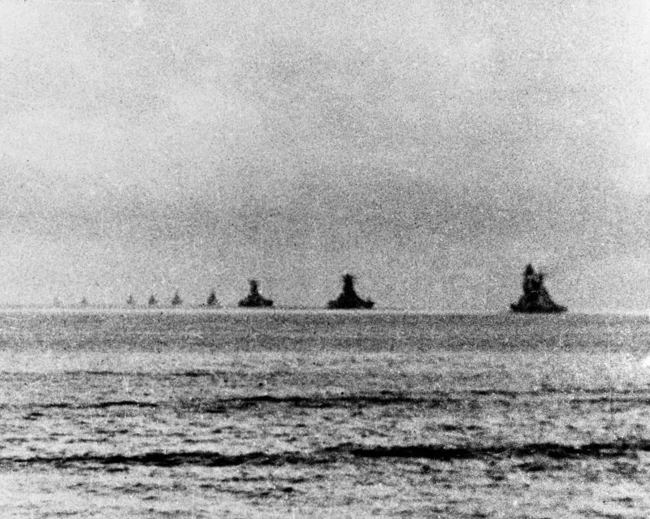
The ships of the "Central Force" leave Brunei Bay in the direction of Leyte Gulf in the Philippines. The second and third ships from the right are the battleships IJN Musashi and IJN Yamato
The center group was supposed to pass through the Sibuyan Sea and the San Bernardino Strait to strike the American forces from the north. However, on October 23, it suffered its first losses: two heavy cruisers were sunk as a result of an attack by American submarines. Soon, the group was discovered by air reconnaissance, which marked the beginning of massive strikes by carrier-based aircraft from the aircraft carriers Intrepid, Essex, Lexington, Franklin, Enterprise, and Cabot.
Lion vs. Buffalo
On the morning of October 24, in the Sibuyan Sea, the 72,000-ton Musashi became the main target of American aviation. Despite its powerful anti-aircraft armament—about 130 guns, mostly obsolete 25mm machine guns—the lack of fighter cover left it vulnerable to air attack.
The first wave of attacks began at 10:27. Nineteen Hellcat fighters, 13 Avenger torpedo bombers, and 12 Helldiver dive bombers armed with half-ton high-explosive bombs took off from the carriers Intrepid and Cabot. Despite intense anti-aircraft fire, which shot down two torpedo bombers and one fighter, Musashi received a torpedo hit on the starboard side near frame 130, causing about 3,000 tons of water to enter boiler room No. 11. One of the bombs hit turret No. 1, but did not penetrate the armor. The list, which had reached 5.5°, was reduced to 1° by counter-flooding. Explosions at frame 20 led to the flooding of several auxiliary compartments, but the crew managed to maintain a speed of 24 knots. 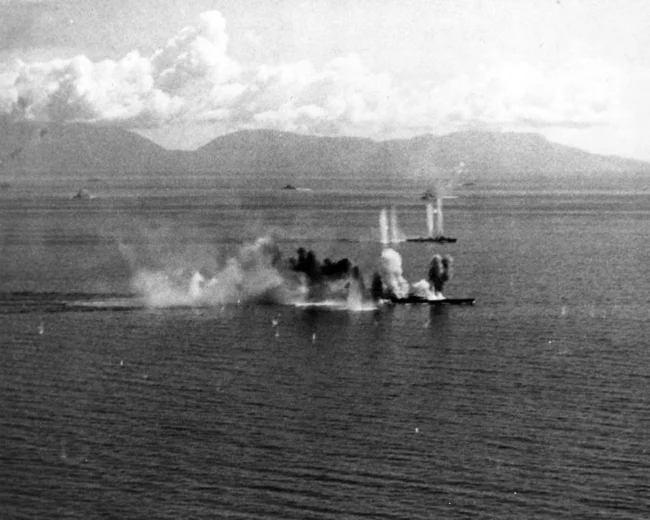
American carrier-based aircraft of the 38th task force attack the battleship IJN Musashi, surrounded by explosions. The Americans lost 18 aircraft out of 259 that participated in the attacks
At 11:40, the battleship was hit again — about 30 aircraft from the aircraft carriers Lexington and Essex scored 2 bomb hits and 1 torpedo hit. Damage to the superstructure and steam line led to the evacuation of the engine room on the left side. The torpedo hit the area of the 143rd frame and flooded the hydraulic machinery compartment. The speed dropped to 22 knots, and the ship began to list to the left side.
At approximately 12:15, the third wave of 80 aircraft from the aircraft carriers Enterprise and Franklin struck Musashi. A torpedo hit her at frame 60, causing a trim of 1.8-2.0 meters by the bow. Despite this, the ship remained in formation.
The fourth attack, which began at 12:45, was carried out from the aircraft carrier Intrepid. The battleship received 3 torpedo hits in the areas of frames 70 and 136. Another 4 bombs caused moderate damage to the living quarters, the forecastle, and the funnel, where the anti-aircraft artillery ammunition detonated. The trim reached 4 m, the speed dropped to 16 knots. Musashi began to lag behind the formation. He was accompanied by the heavy cruiser Tone, and later by the destroyers Hamakaze and Kiyoshio.
The fifth wave, launched from the aircraft carriers Lexington and Essex at 13:20, bypassed Musashi, switching to other targets. The ship continued to move at a speed of 12 knots, with 3 engine rooms operating.
The sixth attack, which began at 15:20, proved decisive. Aircraft from Enterprise and Franklin scored 10 bomb and 4 torpedo hits. The forward turret and radio room were disabled, the decks were damaged, and the ship's commander was seriously wounded. Torpedoes flooded the forward magazines, engine room, and boiler room No. 8. The list increased to 10-12°, the speed dropped to 6 knots. 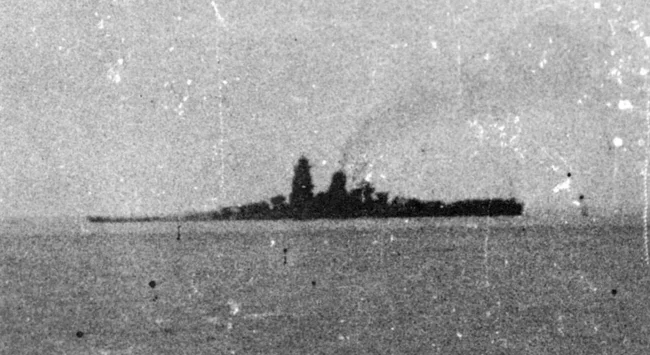
The last photo of IJN Musashi. A strong trim by the bow is visible
By 16:21 the trim by the bow was already 8 m. By 19:00 the water covered the deck up to the main battery turret, the list reached 15°. All engine rooms were out of order. The ship lost its speed and was doomed. The crew was ordered to abandon the battleship, and at 19:36 the Musashi capsized and sank at a depth of about 1 km. 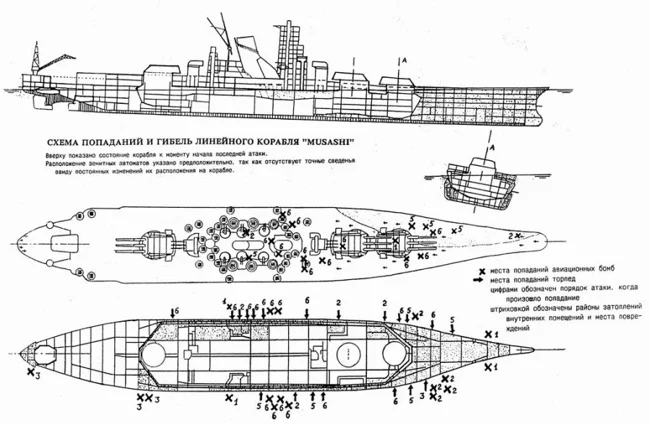
Presumed hit pattern on IJN Musashi
The relatively slow sinking of the battleship allowed the destroyers to evacuate the crew. Despite the serious damage that Kiyoshio had received by that time, she and another destroyer managed to take on board as many people as two small ships could physically accommodate. On Musashi's last voyage, 991 people shared the ship's fate.
During several hours of intense air attacks, the battleship received up to 19 torpedo hits and up to 17 bomb hits. The exact numbers remain a matter of debate due to the difficulty of counting hits in combat and differences in American and Japanese records.
Despite being lost in October 1944, Musashi was not removed from the navy list until August 31, 1945, two days before the end of World War II.















